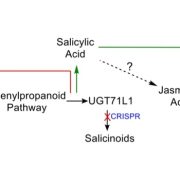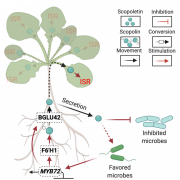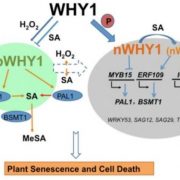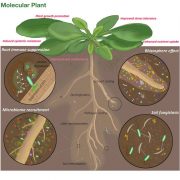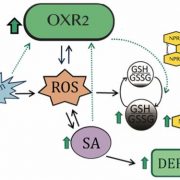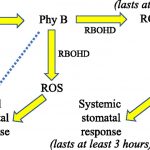Zones of Defense? SA Receptors Have it Under Control
The constant evolutionary arms race with pathogens has equipped plants with a layered immune system. As the first line of defense, membrane-localized pattern recognition receptors perceive microbe-associated molecular patterns and activate pattern-triggered immunity (PTI). In parallel, R proteins – mainly nucleotide-binding leucine-rich repeat receptors – perceive effectors secreted by pathogens to suppress plant defense responses, leading to the activation of effector-triggered immunity (ETI). Both PTI and ETI rely on the production of salicylic acid (SA), which also protects distal tissues from subsequent infections via systemic acquired resistance (SAR). N-hydroxypipecolic acid (NHP) appears to be the mobile signal that moves from locally-infected to systemic tissues and activates SAR (Hartmann et al., 2018; Chen et al., 2018).
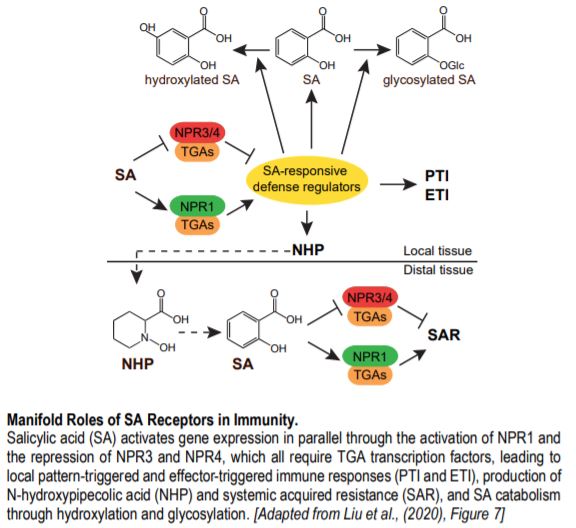 SA is perceived by two classes of receptors – NONEXPRESSER OF PR GENES 1 (NPR1) and NPR1-LIKE PROTEIN 3 and 4 (NPR3/NPR4) – which positively and negatively regulate transcription of SA-dependent genes via TGACG SEQUENCE-SPECIFIC BINDING PROTEIN (TGA) transcription factors, respectively. Binding of SA to NPR1 activates NPR1 and induces SA-dependent gene expression, whereas NPR3/NPR4 repress transcription in the absence of SA and the repression is released upon binding of SA by NPR3/NPR4 (Ding et al., 2018). The npr4-4D dominant-negative mutant has constitutively suppressed SA responses (Ding et al., 2018). In this issue of The Plant Cell, first authors Yanan Liu and Tongjun Sun and colleagues (Liu et al., 2020) systematically dissected the roles of the SA receptors in immunity with the help of the npr1-1 npr4-4D double mutant, in which the perception of SA by all three receptors (NPR1, NPR3, and NPR4) is blocked. They discovered that SA perception and signaling through both receptor types is required for PTI, ETI, biosynthesis of NHP and activation of SAR, as well as regulation of SA catabolism.
SA is perceived by two classes of receptors – NONEXPRESSER OF PR GENES 1 (NPR1) and NPR1-LIKE PROTEIN 3 and 4 (NPR3/NPR4) – which positively and negatively regulate transcription of SA-dependent genes via TGACG SEQUENCE-SPECIFIC BINDING PROTEIN (TGA) transcription factors, respectively. Binding of SA to NPR1 activates NPR1 and induces SA-dependent gene expression, whereas NPR3/NPR4 repress transcription in the absence of SA and the repression is released upon binding of SA by NPR3/NPR4 (Ding et al., 2018). The npr4-4D dominant-negative mutant has constitutively suppressed SA responses (Ding et al., 2018). In this issue of The Plant Cell, first authors Yanan Liu and Tongjun Sun and colleagues (Liu et al., 2020) systematically dissected the roles of the SA receptors in immunity with the help of the npr1-1 npr4-4D double mutant, in which the perception of SA by all three receptors (NPR1, NPR3, and NPR4) is blocked. They discovered that SA perception and signaling through both receptor types is required for PTI, ETI, biosynthesis of NHP and activation of SAR, as well as regulation of SA catabolism.
The authors found that while SAR and induction of NHP biosynthesis genes were compromised in npr1-1 and npr4-4D single mutants, they were completely abolished in the npr1-1 npr4-4D double mutant. Indeed, only trace amounts of NHP and its precursor pipecolic acid were detected in pathogen-challenged npr1-1 npr4-4D plants. Notably, the double mutant was unable to induce SAR. These results indicated that SA perception is critical for systemic resistance signaling, including NHP biosynthesis and NHP-induced immunity.
After establishing that both classes of SA receptor were required for systemic immune responses, the authors analyzed their role in PTI and ETI. They determined that both PTI and ETI responses and the induction of respective immune response marker genes were more severely compromised in npr1-1 npr4-4D plants than in the single mutants, suggesting that SA perception participates in PTI and ETI responses.
Interestingly, the authors observed that PTI, ETI, and SAR were all more severely impaired in npr1-1 npr4-4D than in the sid2-1 mutant, which is deficient in SA biosynthesis. These data suggest that the perception of SID2-independent basal SA levels by NPR1/3/4 makes an essential contribution to plant immune activation.
The authors also addressed the role of NPR1 and NPR3/4 in SA homeostasis and found that basal levels of conjugated forms such as hydroxylated SA and pathogen-induced glycosylated SA, but not free SA levels, were severely reduced in the npr1-1 npr4-4D double mutant. SA- and pathogen-triggered induction of genes involved in SA hydroxylation and glycosylation was abolished in npr1-1 npr4-4D, compared to a mere reduction of expression in the single mutants. Thus, the NPR1- and NPR3/4-dependent SA perception pathways may regulate SA catabolism in parallel.
The study by Liu et al. (2020) provides a thorough analysis of the contribution of SA signaling through NPR1 and NPR3/4 to local and systemic defense responses and indicates that most SA-triggered immune responses in plants require both types of SA receptors.
Hanna Hõrak
Institute of Technology
University of Tartu, Estonia
ORCID: 0000-0002-6392-859X
REFERENCES
Chen, Y.-C., Holmes, E.C., Rajniak, J., Kim, J.-G., Tang, S., Fischer, C.R., Mudgett, M.B., and Sattely, E.S. (2018). N-hydroxy-pipecolic acid is a mobile metabolite that induces systemic disease resistance in Arabidopsis. Proc. Natl. Acad. Sci. 115: E4920–E4929.
Ding, Y., Sun, T., Ao, K., Peng, Y., Zhang, Y., Li, X., and Zhang, Y. (2018). Opposite Roles of Salicylic Acid Receptors NPR1 and NPR3/NPR4 in Transcriptional Regulation of Plant Immunity. Cell 173: 1454-1467.e15.
Hartmann, M., Zeier, T., Bernsdorff, F., Reichel-Deland, V., Kim, D., Hohmann, M., Scholten, N., Schuck, S., Bräutigam, A., Hölzel, T., Ganter, C., and Zeier, J. (2018). Flavin Monooxygenase-Generated N-Hydroxypipecolic Acid Is a Critical Element of Plant Systemic Immunity. Cell 173: 456-469.e16.


